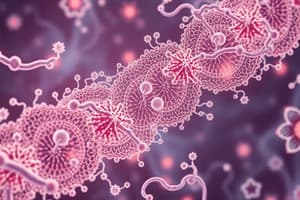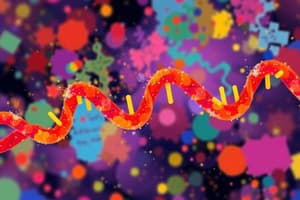Podcast
Questions and Answers
Which subunit of RNA polymerase is primarily responsible for recognizing promoter sequences on DNA?
Which subunit of RNA polymerase is primarily responsible for recognizing promoter sequences on DNA?
- α subunit
- ω subunit
- β' subunit (correct)
- β subunit
What is the typical error rate of RNA polymerase during transcription in prokaryotes?
What is the typical error rate of RNA polymerase during transcription in prokaryotes?
- 1 error in 10,000 bases (correct)
- 1 error in 1,000 bases
- 1 error in 100,000 bases
- 1 error in 1,000,000 bases
Which of the following correctly describes the consensus sequences found in prokaryotic promoters?
Which of the following correctly describes the consensus sequences found in prokaryotic promoters?
- Three consensus sequence elements within 40 bp
- Consensus sequences only present in eukaryotes
- Two consensus sequence elements at -10 and -35 (correct)
- A single consensus sequence at -10
During the initiation of polymerization, which nucleoside triphosphates does RNA polymerase preferentially bind first?
During the initiation of polymerization, which nucleoside triphosphates does RNA polymerase preferentially bind first?
What is the primary role of the ω subunit in the RNA polymerase complex?
What is the primary role of the ω subunit in the RNA polymerase complex?
Flashcards
RNA Polymerase in Prokaryotes
RNA Polymerase in Prokaryotes
A protein complex responsible for RNA synthesis in prokaryotes, containing 5 subunits with distinct roles.
Promoters in Prokaryotes
Promoters in Prokaryotes
DNA sequences recognized by RNA polymerase to initiate transcription. These sequences are typically around 40 base pairs long and contain two key elements: -35 region and Pribnow box.
Initiation of Transcription
Initiation of Transcription
The stage of transcription where the RNA polymerase binds to the promoter, unwinds DNA, and initiates the formation of the first phosphodiester bond.
Role of Sigma Subunit
Role of Sigma Subunit
Signup and view all the flashcards
Elongation in Transcription
Elongation in Transcription
Signup and view all the flashcards
Study Notes
Transcription in Prokaryotes
- Prokaryotic transcription uses a single RNA polymerase.
- In E. coli, RNA polymerase is a 465 kD complex.
- It has multiple subunits: 2 α, 1β, 1β', 1 ω & 1σ.
- The RNA polymerase holoenzyme recognizes promoter sequences on DNA.
- Subunits are essential for assembly and activation by regulatory proteins.
- The polymerase is accurate, with approximately one error in 10,000 bases.
- This error rate is acceptable due to many transcripts produced from each gene.
Objectives
- Transcription in prokaryotes
- Properties of promoters in prokaryotes and eukaryotes
- Comparison of transcription in prokaryotes and eukaryotes
Stages of Transcription
- RNA polymerase holoenzyme binds to promoter sites.
- Polymerization initiates.
- Chain elongation occurs.
- Transcription terminates.
Properties of Promoters
- Promoters are typically 40 base pairs long.
- They are located on the 5' side of the transcription start site.
- Two consensus sequence elements:
- The -35 region: consensus TTGACA. Sigma subunit binds here.
- The Pribnow box (-10): consensus TATAAT. Ideal for unwinding.
Properties of Eukaryotic Promoters
- Eukaryotic gene promoter sequences typically lie between 45 to 55 bases.
- They include consensus sequences like the CAAT box (GGCCAATCT) and the TATA box (TATAAAA).
1- Initiation of Polymerization
- RNA polymerase has two binding sites for NTPs.
- The initiation site prefers ATP and GTP (most RNAs start with a purine at the 5' end).
- The elongation site binds the next incoming NTP.
- The 3'-OH of the first NTP attacks the alpha-phosphate of a second NTP, forming a phosphodiester bond.
- When 6-10 nucleotides have been added, the sigma subunit dissociates, completing initiation.
- Rifamycin and rifampicin inhibit transcription by binding to RNA polymerase.
2- Chain Elongation
- Core polymerase (without sigma subunit) elongates the RNA chain.
- Elongation rate is 20-50 bases per second, slower in G-C rich regions.
- Topoisomerases aid by relieving supercoiling ahead of and behind the polymerase.
3- Chain Termination
- Termination occurs by two mechanisms:
- Rho-dependent: ATP-dependent helicase unwinds the RNA transcript, causing termination.
- Rho-independent: Inverted repeat sequences transcribed into RNA create a hairpin loop, leading to termination. (Hair pin loop often followed by several uracils).
Termination Strategies in Bacteria
- Rho-dependent termination: Rho protein binds to the RNA and moves to the termination site, causing termination.
- Rho-independent termination: Sequence in DNA that forms the termination hairpin, along with a series of U's (often 4-9) in the mRNA triggers detachment of the polymerase.
Rho-Protein
- Rho is an essential protein for prokaryotic transcription termination.
- It unwinds the RNA-DNA hybrid helix.
Comparison of Transcription in Prokaryotes and Eukaryotes
| Feature | Prokaryotes | Eukaryotes |
|---|---|---|
| Transcription & translation | Occur simultaneously | Occur separately |
| Process | Simple (polycistronic) | More complicated (monocistronic) |
| mRNA | No modification needed | Needs modifications (capping, splicing, polyadenylation) |
| Enzymes involved | Single RNA polymerase | RNA polymerases I, II, III |
| Termination | Well understood | Less clear |
| DNA | Circular, free in cytoplasm | Linear, within the nucleus, associated with histones |
| RNA polymerase | Made up of 5 subunits | Made up of 10-15 subunits |
Studying That Suits You
Use AI to generate personalized quizzes and flashcards to suit your learning preferences.




